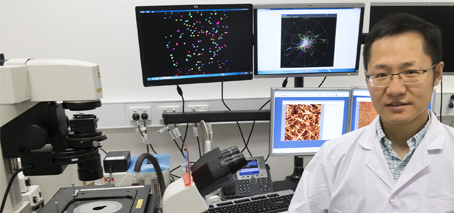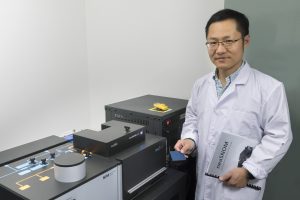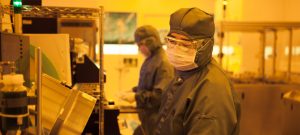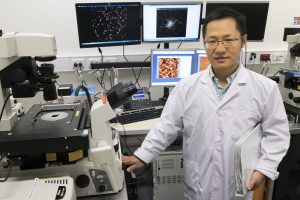FLEET-nano collaboration recognised: Congratulations to Qiaoliang Bao, 2018 ANFF-VIC Technology Fellow
Qiaoliang Bao works at the nanoscale, trapping photons in atomically-thin, two-dimensional materials, where high binding energies create a quantum state known as a superfluid.
The aim is a new generation of superfluid transistors that will ‘switch’ using much less energy than conventional electronics.
Such work requires access to the best nanofabrication and characterisation facilities, and Qiaoliang’s team at Monash University’s Faculty of Engineering works closely with the Melbourne Centre for Nanofabrication (MCN), the flagship facility of the Australian National Fabrication Facility (ANFF).
This close and fruitful collaboration has recently been recognised with Qiaoliang appointment as a 2018 ANFF-VIC Technology Fellow.
The MCN is Australia’s largest open-access nanofabrication cleanroom, an open-access research and development facility where users such as Qiaoliang can fabricate structures on a nanometre-scale, using techniques such as electron-beam lithography or focused ion beam lithography.
The ANFF-VIC Technology Fellow Ambassador Program forges a strong Australian nanofabrication community, improves procedures, and creates ‘champions’ of ANFF facilities. As a Technology Fellow, Qiaoliang will also take an active role in guiding the broad scientific direction of ANFF-VIC, and provide in-kind expertise for two important fabrication projects at the MCN: nanoscale waveguide for 2D materials and high-Q distributed Bragg reflector.
Light-matter particles and the search for dissipationless transistors
Within FLEET (see below), Qiaoliang Bao investigates waveguide-coupled 2D semiconductors and plasmon-coupled 2D materials and devices, focusing on the effect of confined-space light-matter interactions on the transport of electrons or other quasi-particles such as polaritons.
Photons behave in strange, useful ways when confined to very small volumes, such as within a micrometre-scale structure known as a microcavity, an optical medium sandwiched between ultra-reflective mirrors.
Interactions in this confined space can be used to create super-positions of light and matter, forming quasiparticles known as polaritons.
In an atomically-thin material, the binding energy between particles can be reduced such that a quantum state known as a superfluid is created, in which charged particles flow without encountering any resistance to their motion.
In a superfluid, scattering is prohibited by quantum statistics, which means that charge carriers can flow without resistance.
Using such ‘dissipationless’ conduction paths, ultra-low energy superfluid transistors can be created that will switch using much less energy than traditional silicon-based technology.
In exciton superfluid transistors, the superfluid state would be switched on and off, similar to closed (1) and open (0) states in traditional transistors.
The three specific scientific aims of the proposed project for the MCN Technical Fellowship are:
- investigating strong electron-photon coupling in atomically thin crystals
- observing exciton polaritons and condensation in atomically thin crystals
- demonstrating excitonic lasing in atomically thin crystals at room temperature.
FLEET & ICT energy use
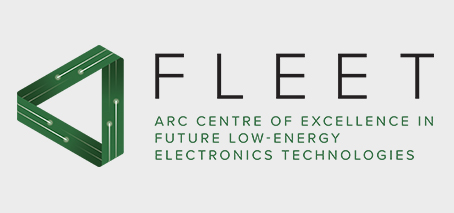 Qiaoliang is one of almost a hundred researchers at FLEET, all motivated by one grand challenge: to reduce the energy used in information and communication technology (ICT), which already accounts for at least 5% of global electricity use, and is doubling every decade
Qiaoliang is one of almost a hundred researchers at FLEET, all motivated by one grand challenge: to reduce the energy used in information and communication technology (ICT), which already accounts for at least 5% of global electricity use, and is doubling every decade
FLEET (the ARC Centre of Excellence in Future Low-Energy Electronics Technologies) will develop systems in which electricity flows with minimal resistance and therefore minimal wasted dissipation of energy, and devices in which this ‘dissipationless’ electric current can be switched on and off at will.
These devices will enable revolutionary new electronics and communications technologies with ultra-low energy consumption.
For the new technology to compete with silicon, it will be necessary that the novel and atomically-thin materials developed at FLEET be incorporated into functioning, nano-scale electronics. Such work is coordinated under the Centre’s Enabling Technology B, nano-device fabrication. (Qiaoliang also studies waveguide-coupled 2D semiconductors, within the Centre’s Research Theme 2, exciton superfluids.)
FLEET uses a range of advanced fabrication techniques to incorporate atomically-thin materials into novel device structures. To realise exciton-superfluid transistors, in which the superfluid state can be switched on and off, atomically-thin semiconductors must be integrated with optical cavities.
Several of Qiaoliang’s colleagues at FLEET will also access MCN facilities under the Fellowship: Michael Fuhrer and Agustin Schiffrin (Monash University), and Kourosh Kalantar-zadeh and Lan Wang (RMIT).
Cutting-edge nanofabrication
The Melbourne Centre for Nanofabrication has the largest and broadest capability within ANFF. Among the facilities specifically used by Qiaoliang are:
- scanning near-field optical microscopy (SNOM)
- atomic force microscopy (AFM)
- integrated focused ion beam lithography and scanning electron microscope (FIB-SEM)
- plasmon-enhanced vapour deposition (PVD)
- atomic layer deposition (ALD)
- e-beam evaporation
- micro-nano lithography (including nanoimprint lithography and electron beam lithography).
International conference on 2D materials and technologies
![]() Qiaoliang is co-Chair of the ICON-2DMat 2018 Conference, to be held in Melbourne in December 2018. Reflecting the rapidly growing field of 2D materials, the conference will cover graphene, transition metal dichalcogenides, black phosphorus, topological insulators, perovskites, MX3 and other new forms of 2D materials, as well as developing applications in electronics, photonics, optoelectronics, catalysis, bio-medical, environmental and energy.
Qiaoliang is co-Chair of the ICON-2DMat 2018 Conference, to be held in Melbourne in December 2018. Reflecting the rapidly growing field of 2D materials, the conference will cover graphene, transition metal dichalcogenides, black phosphorus, topological insulators, perovskites, MX3 and other new forms of 2D materials, as well as developing applications in electronics, photonics, optoelectronics, catalysis, bio-medical, environmental and energy.
More information:
- A/Prof Qiaoliang Bao qiaoliang.bao@monash.edu
- Monash Materials Science Monash.edu/engineering/qiaoliangbao
- Melbourne Centre for Nanofabrication (MCN) Nanomelbourne.com
- ICON-2DMat 2018 Conference FLEET.org.au/ICON2DMAT
- FLEET communications media@FLEET.org,au
Images
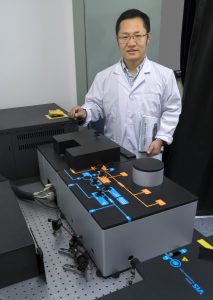
Qiaoliang Bao with the neaSNOM Microscope, combining imaging & spectroscopy in the visible, infrared and even terahertz spectral region at 10 nm spatial resolution

